
India is a huge and diverse destination. More than twenty official languages, multiple religions and a varied range of cuisines exist within this sub-continent, which is bordered by seven countries as well as the Arabian Sea and the Bay of Bengal.
Travel is the only way to truly experience the breadth of Indian culture and history, so give yourself plenty of time and head to as many of these best places to visit in India, as your itinerary allows.
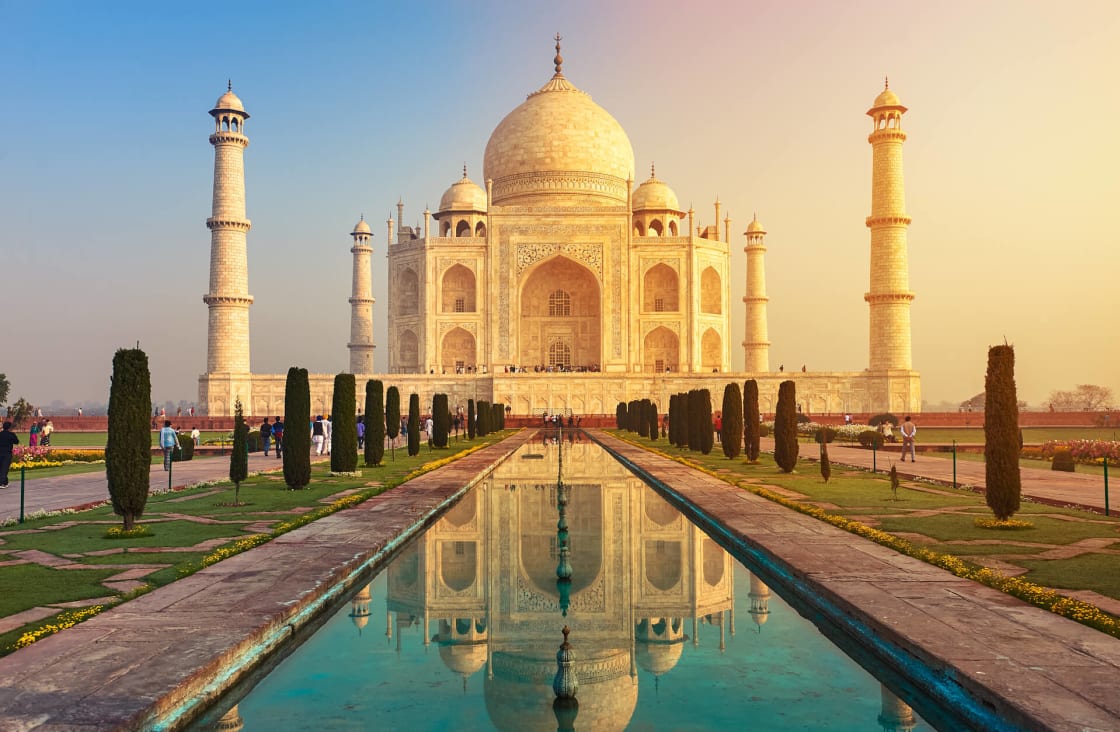
The Taj Mahal in Agra is rightly one of the Seven Wonders of the World and not to be missed.
Situated on the banks of the River Yamuna, this populous must-visit city in Uttar Pradesh, is home to one of the seven wonders of the world, the Taj Mahal. It’s a monument that inspires millions of tourists to visit India and to wake before dawn to see it radiate and change color at sunrise. Indeed, if there was just one icon to symbolize all of India, it would be the Taj Mahal.
Agra also has many other marvelous Mughal monuments, such as Itimad-ud-Daulah’s Tomb and Akbar’s Mausoleum, as well as two other UNESCO World Heritage Sites, the Agra Fort and Fatehpur Sikri. Be prepared to be astonished, astounded, amazed, and thrilled.
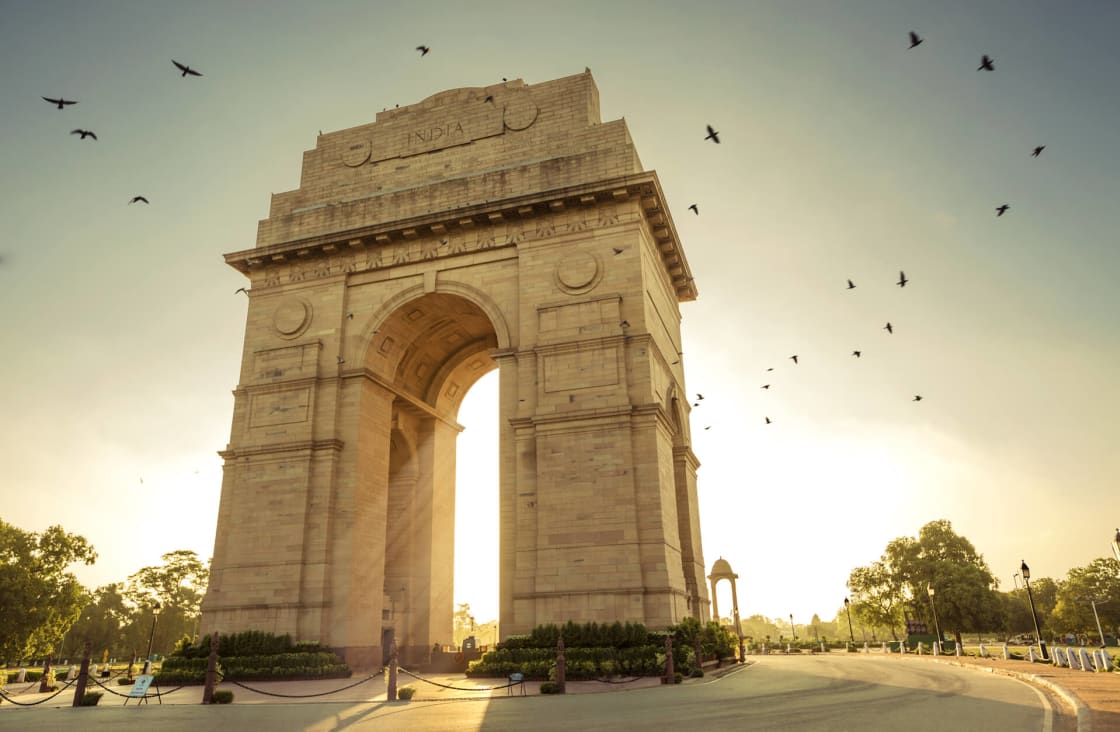
Delhi’s India Gate stands as a memorial to the 84,000 soldiers of the British Indian Army who died in the First World War.
The vibrant capital of India, Delhi is a cosmopolitan city offering many exciting contrasts between the historic old Delhi and the modern New Delhi. Despite its crowds and chaos, the city offers a lot to love, the perfect marriage of heritage and modernity. Take time to explore historical Mughal monuments such as the Red Fort and Jama Masjid in Old Delhi, and Humayun’s Tomb and Purana Qila in New Delhi.
Other top attractions in New Delhi include the India Gate; India’s tallest minaret, Qutub Minar; the Akshardham Temple; the Lotus Temple, also known as the Bahai Temple; and the huge ISKON Temple complex. In fact, throughout the sprawling city, you can explore countless sites of spiritual and cultural importance. The narrow, winding lanes of old Delhi are a testament to the former Mughal rule, and the district houses one of the country’s oldest and busiest markets – the famous Chandni Chowk.
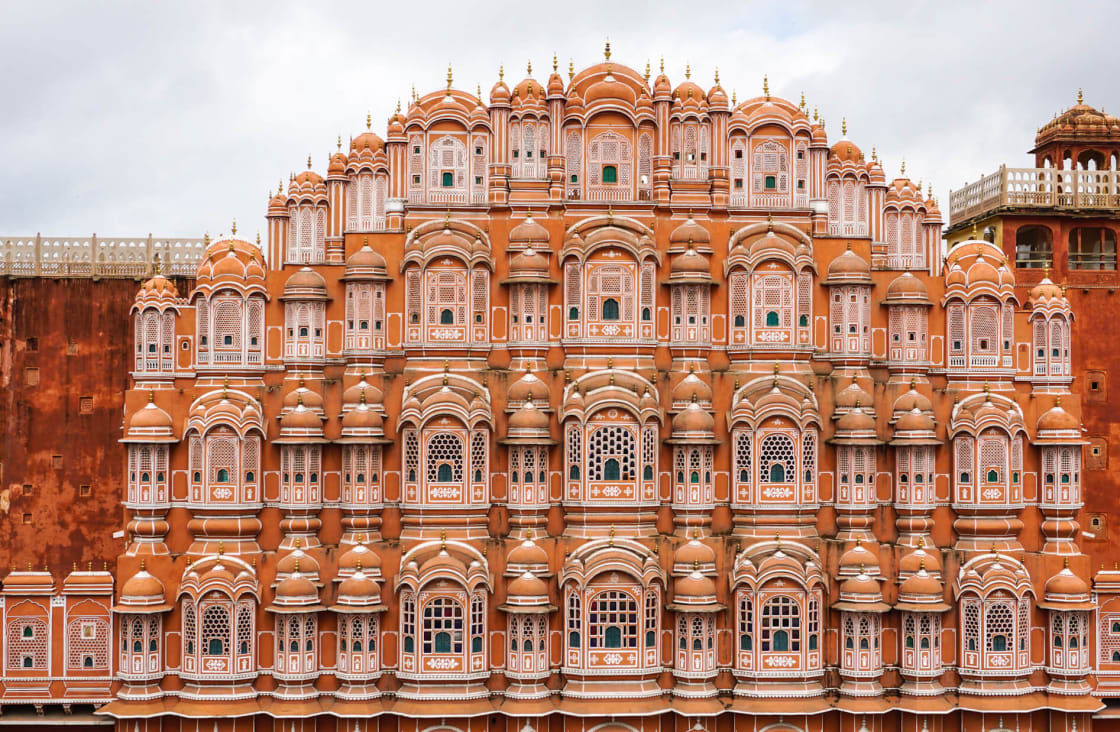
The spectacular Hawa Mahal (Palace of the Winds) with its five-story frontage and fusion of Hindu and Islamic architecture.
Dubbed the Pink City and the “Paris of India”, Jaipur is the capital of the royal state of Rajasthan. Along with Delhi and Agra, it forms the Golden Triangle, which hails as one of the most famous tourist circuits in the country. The beautiful, blushed pink, crenellated walls and the huge gateways protecting and guarding the entrance to the city are embellished with drawings and olde-world charm. The city is home to some splendid forts and palaces, temples and museums, streets lined with silversmiths, gem polishers, textile shops, and tailors working in open doorways on treadle sewing machines, as well as a treasure trove of bustling bazaars, famous in particular for Rajasthan jewelry.
The City Palace showcases an exquisite blend of Mughal and Rajput architecture, its delicately painted walls housing museums of art and clothes, while a private section is still home to the last ruling royal family. The Hawa Mahal or Palace of the Winds is a fusion of Hindu and Islamic architecture, featuring an incredible five-story frontage with latticed windows, called jharokhas, designed for the royal ladies to watch the comings and goings on the streets below without fear of being observed by the common man. The Jantar Mantar is the observatory, with a garden filled with massive masonry instruments used for telling the time and studying the sun, the stars and the planets.
Seven miles outside Jaipur is the Amber Palace, a high fortress nestled between the Aravalli hills and surrounded by magnificent countryside. Here, you can wander freely through the stronghold of an ancient kingdom, where turrets and towers, lookout posts, and ornate stucco walls, decorated with millions of pieces of glass, will draw you back into a bygone century.
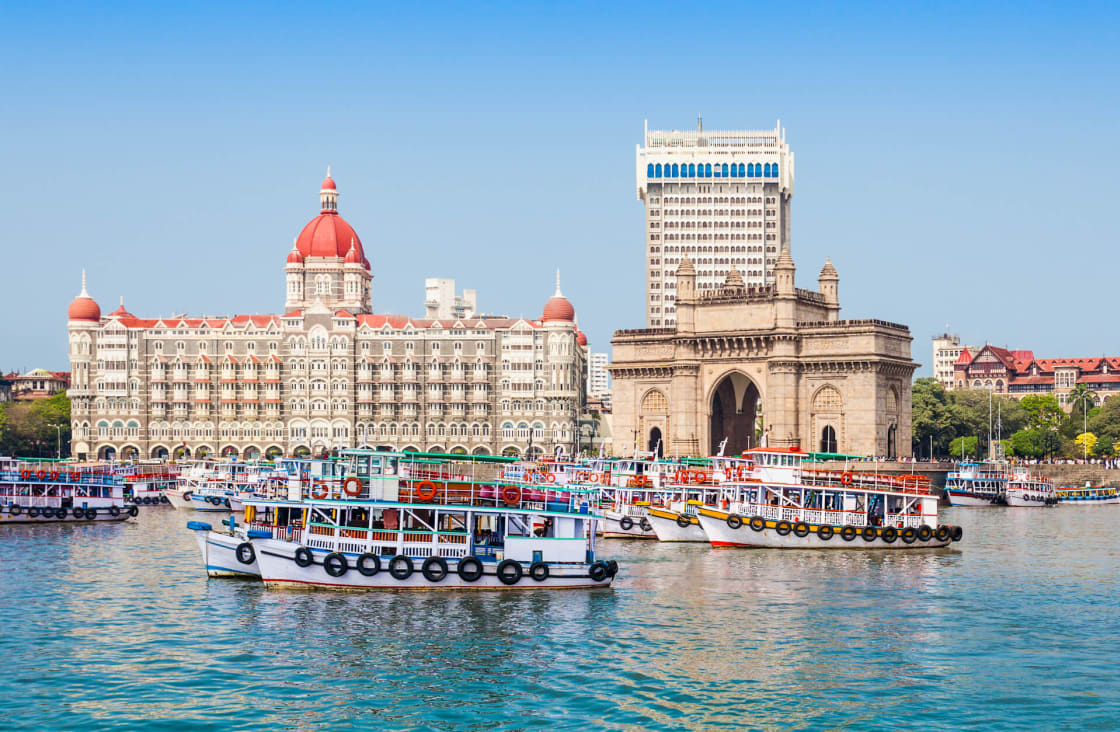
The luxurious Taj Mahal Palace Hotel and iconic Gateway of India are located on Mumbai’s waterfront at Apollo Bunder, overlooking the Arabian Sea.
Mumbai, the dynamic, coastal, cosmopolitan capital city of the Indian state of Maharashtra, is a dramatic paradox of chaos and hope, glamor and squalor, modernity and tradition. Notoriously branded the City of Dreams, Mumbai – formerly known as Bombay – is a brilliantly blended melting pot of cultures and lifestyles. The city absorbs everything into its structure.
From struggling actors to the hottest Bollywood superstars, from big industrialists and ultra-wealthy entrepreneurs to tribes of fisherman and slum dwellers, Mumbai is a city that tells a multitude of stories from different walks of human survival.
You’ll never be far from five-star hotels or gourmet restaurants in this luxe city. A cruise down the beloved Marine Drive will make you feel like royalty as you catch a glimpse of the scenic coast and glamorous Art Deco buildings. Alternatively, you can observe a more authentic, local side of Mumbai in the bustling “Thieves Market” or at the Churchgate Railway Station, where hundreds of thousands of homemade lunches are packed up for delivery to the city’s office workers every day. Make sure you devote a day to checking out Sanjay Gandhi National Park and exploring the 2,000-year-old Kanheri Cave carvings.
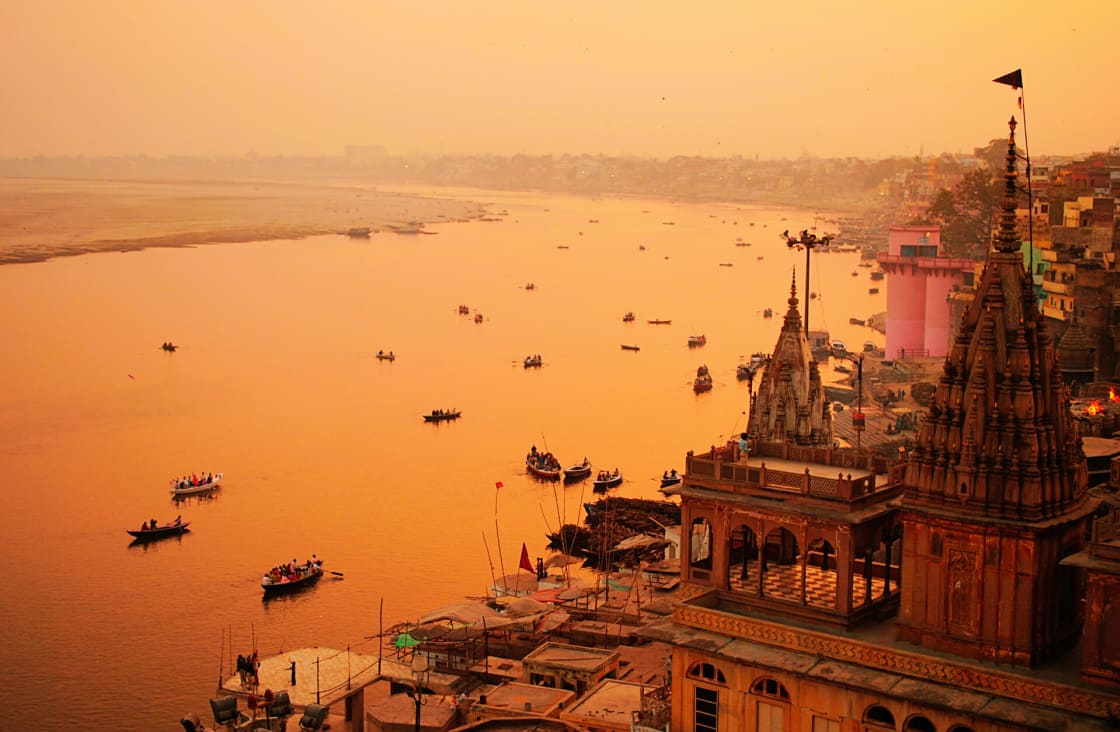
Dusk at Varansi on the banks of the Ganges marks the beginning of the beautiful, daily Ganga Aarti ceremony when priests offer prayers to the holy river.
The world’s oldest living city, Varanasi, also known as Kashi (City of Life) and Benaras, is the spiritual capital of India and one of Hinduism’s seven holy cities. It lies along the western banks of the River Ganges, spread across a maze of narrow galis (winding streets). The spiritual activities take place along the sacred river, where pilgrims bathe and mourners cremate recently deceased relatives in plain view of passers-by. Here, you can find your own flavor of spiritualism by taking a sunrise boat ride, releasing floral blessings to float upon the river, and watching the fire-filled Hindu chanting ceremonies from the steep ghats (riverfront steps).
Away from the water, the streets of the old town twist and turn like a never-ending labyrinth, in fact, legend has it that there’s still no accurate map of Varanasi. The city is considered an auspicious place to die, as it is believed to grant moksha or liberation from the cycle of life and death. Life, and death rituals, are centered around the ghats, about 80 of which border the Ganges. Be sure to take a break at dusk when the Ganga Aarti takes place, a daily ceremony of immense splendor.

Goa, a Portuguese territory for almost 450 years, is renowned for its endless stretches of golden-sand beaches.
Positioned on India’s western coast, Goa is the country’s smallest state, renowned for its endless stretches of golden-sand beaches, fabulous nightlife, delicious seafood and world-heritage listed architecture. Its flea markets and beach shacks in the north, and luxurious five-star resorts and laid-back vibes in the south, all along the Arabian Sea, offer something for every type of visitor.
What makes Goa unique is its blend of Indian and Portuguese cultures. You’ll experience the fusion throughout the destination, from its Baroque cathedrals to its spicy vindaloo curries. Goa was a Portuguese territory for almost 450 years and is therefore filled with Portuguese architecture. You’ll see many whitewashed churches and crumbling forts, yellow houses with purple doors, ochre-coloured mansions and oyster shell windows.
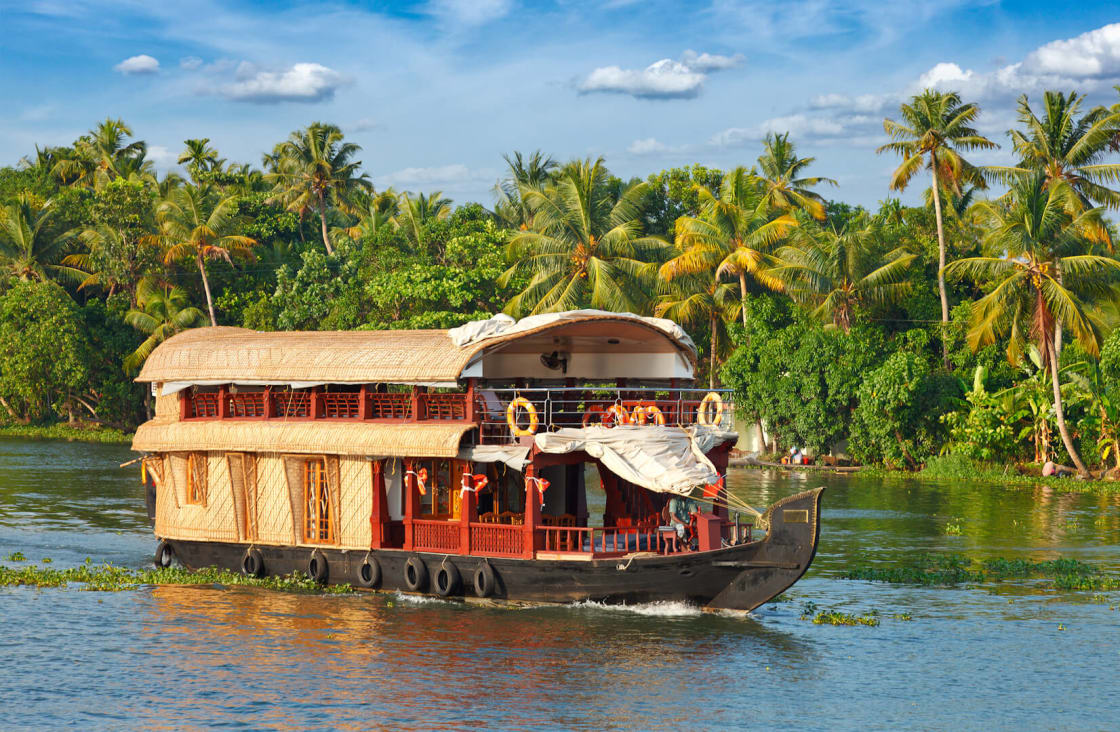
Kerala is known for its palm-lined beaches and backwaters home to a network of tranquil canals and lagoons.
Easy-going Kerala is like a breath of fresh air from the intensity of India’s cities. A wonderful experience is to hop aboard a traditional thatched-roof houseboat in Alleppey (also known as Alappuzha) and slowly cruise through palm-fringed lagoons and rivers, either as a day trip or week-long adventure. You’ll enjoy freshly cooked Indian cuisine on the water and breathtakingly beautiful natural sights and wildlife.
In the Kuttanad region of Alappuzha in August you may be treated to the sight of boat races, in vessels that can hold up to a hundred oarsmen. Thousands of fans line the riverbanks and cheer on their favorite teams which makes for a great atmosphere. There are dozens of villages and communities throughout this area, and you will gain a real sense of everyday life.

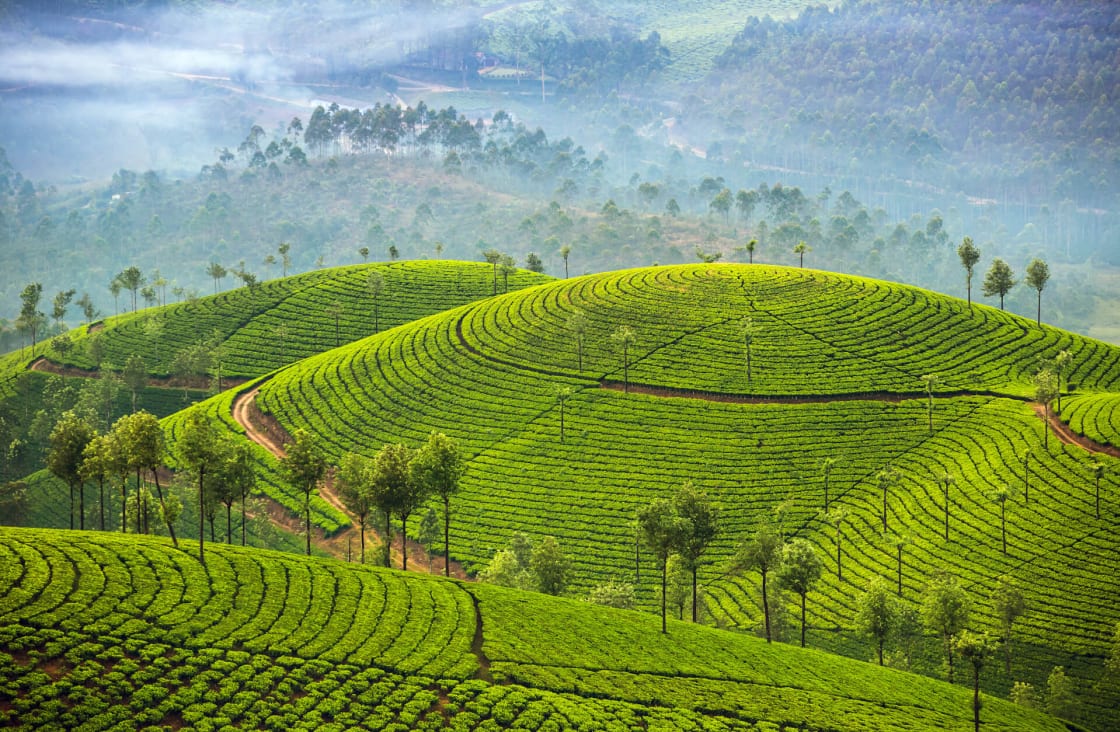
The famous ‘Darjeeling Tea’ is produced by more than 86 tea estates in Darjeeling.
Located in West Bengal, Darjeeling is the former summer capital of India under the British Raj, a beloved hill station, and one of the best places to visit in India. Nestled amidst acres of lush green tea plantations, scenic Darjeeling stands at the height of 6725 feet above sea level, thus boasting a cool climate all year round. Awe-inspiring views of snow-capped peaks (including Khangchendzonga, the world’s third-highest mountain), and serene Buddhist monasteries will greet you. This is the perfect place to arrange a mountain trek or mountain biking adventure.
Tiger Hill is an awesome spot to see the sunrise over the mountains in all its fiery glory. Take a ride on the Darjeeling Himalayan Railway on the 140-year-old “Toy Train”, powered by an antique steam locomotive, which will take you on a two-hour fun ride from Darjeeling to Ghum, a journey that’s regularly counted as one of the most scenic train rides in the world. The famous ‘Darjeeling Tea’ is produced by more than 86 tea estates in Darjeeling; enjoy a cup of this locally brewed chai in situ or get down amidst the plantations to pick some tea leaves yourself.
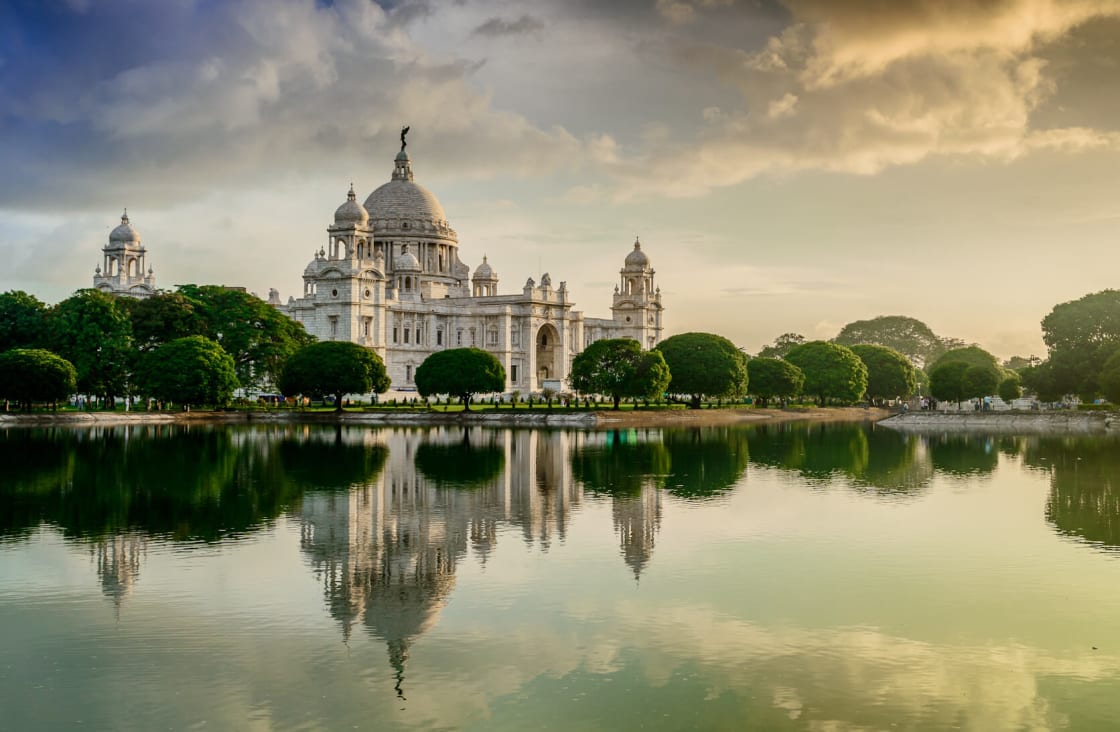
The Victoria Memorial in Kolkata was built between 1906 and 1921 and is dedicated to the memory of Queen Victoria, Empress of India from 1876 to 1901.
Kolkata (formerly Calcutta) is India’s third-most populous city, a vibrant 350-year-old metropolis located on India’s Eastern Coast, the capital of West Bengal, and a crumbling masterpiece of former British India before the government was shifted to Delhi. Kolkata brims with colonial-era architecture and is soaked in layers and layers of heritage and culture. Here you will find an enduring celebration of human existence, concurrently luxurious and squalid, sophisticated and frenetic, emphatically futuristic, while also beautiful in decay.
Kolkata is the artistic and intellectual capital of the country. Driven by the indomitable spirit of the self-made middle class, the city has created a beautiful juxtaposition of the old colonial-era charm with the burgeoning hipster culture that thrives amongst the city’s millennial residents.
If you want to immerse yourself in the imperial past, stroll along the streets of North Kolkata, where you’ll find some of the oldest mansions in the city, draped with vines and a tenacious sense of aristocratic pride. Kolkata is home to Rabindranath Tagore’s ancestral house, which has now been converted into a museum with a staggering collection of family portraits and paintings.
There are plenty of ghats all over the city where you can sit and enjoy a sunset while sipping on tea, one of the most noted of these being the Prinsep Ghat, which offers stunning views of the Vidyasagar Setu in the backdrop.

An estuarine crocodile basking under the tropical sun in Bhitarkanika National Park.
There are 215 species of birds in this sanctuary, of which the most important are the eight varieties of kingfisher and the migratory birds from Europe and Central Asia. Additionally, Bhitarkanika National Park is home to many reptiles, mammals and vertebrates including venomous cobras and Indian pythons, the endangered water monitor lizards, chitals, jungle cats, wild pigs, otters, rhesus monkeys, sambar, spotted deer, wild boar and the fishing cat. Black ibis, egrets, open billed storks, sandpipers, sea eagles, whistling teals, kites, cormorants, darters, and seagulls are frequently seen here.

The prospect of seeing a Royal Bengal Tiger in the flesh draws visitors to the wildlife-rich mangroves of the Sundarbans National Park.
The Sundarbans National Park is a biosphere reserve and a tiger reserve, spread across the world’s largest delta, stretching from the River Hooghly in West Bengal, India, all the way to the River Baleswar in Bangladesh. In this UNESCO World Heritage Site, the mangrove trees stand lazily on the mudflats. The name means “beautiful forests”, and the Sundari trees, which are dominant in this mangrove area, are notable for their roots that shoot upwards for respiration. Wildlife tourism is what draws visitors to Sundarbans. Apart from spotting royal Bengal tigers, other animals found in these areas are fishing cats, macaques, leopard cats, the Indian grey mongoose, wild boars, flying foxes, pangolins, chital deer and rhesus monkeys.
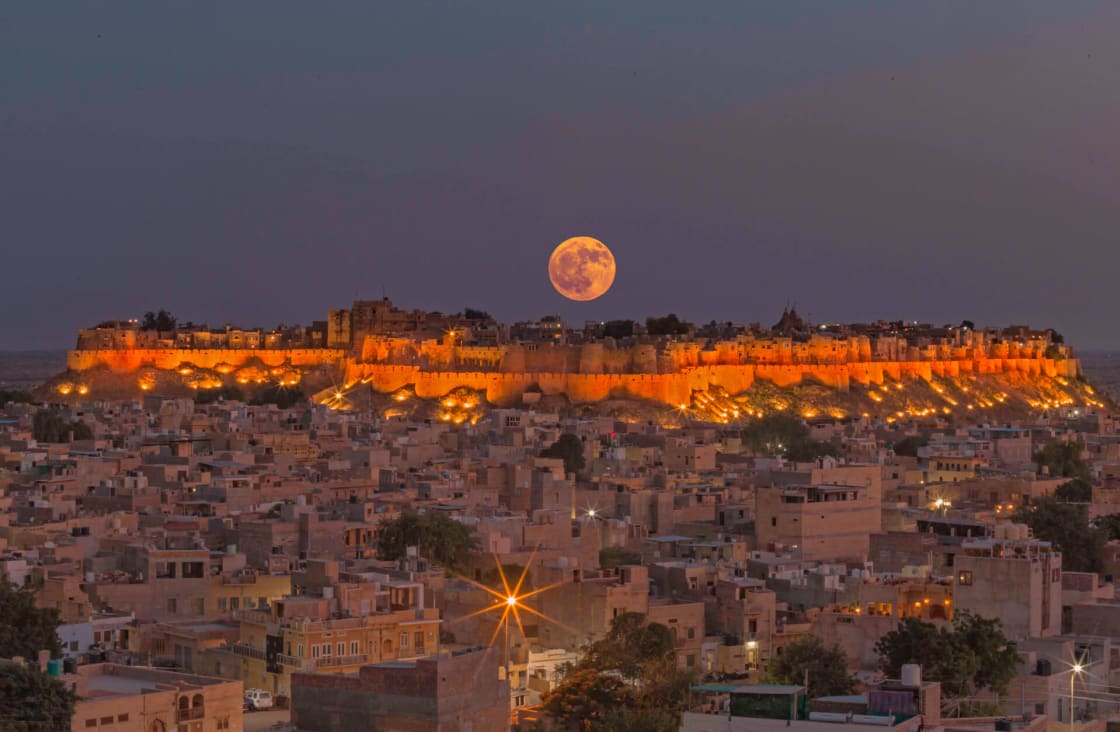
The Jaisalmer Fort, one of the very few “living forts” in the world, stands imperiously at the crossroads of ancient trade routes including the Silk road.
Located in the north-western state of Rajasthan, Jaisalmer is an amalgamation of exotic Indian desert culture, heritage and adventure, reminiscent of a story from the Arabian Nights brought to life. It is known as the ‘Golden City’ due to its golden dunes and castles crafted from golden honey sandstone. It features lakes, ornate Jain temples and havelis. The Jaisalmer Fort has been inhabited by people for generations, it is characterized by narrow alleys and shops selling colorful handicrafts. Climb onto the camel saddle and make your way through this desert to camp under the starry night sky for an unforgettable experience.
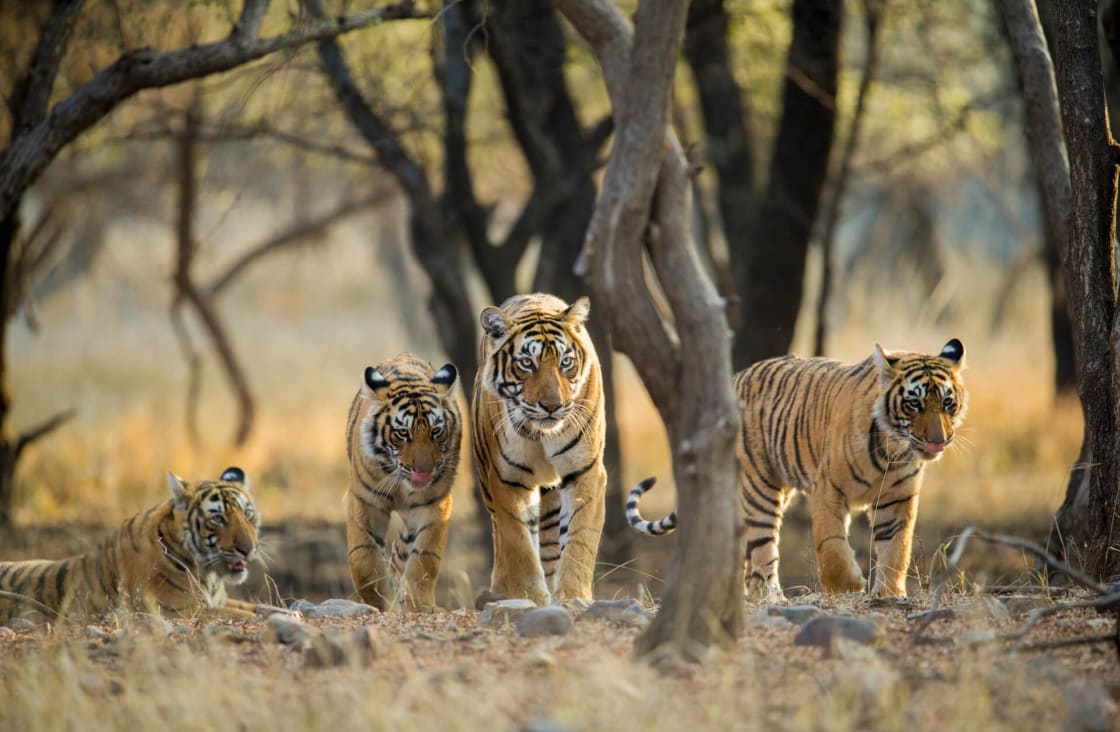
Ranthambore is one of India’s most renowned national parks and arguably the best place in India to spot a tiger.
Situated in the foothills of Vindhya and Aravali Hills, Ranthambore is one of the best tiger reserves in India, and the chances of sighting a tiger here is reasonably better than many other tiger reserves in the country. It is home to a wide variety of exotic species, an absolute delight for birdwatchers and an ideal place to watch animals in their natural habitat.
The Ranthambore Fort, built in the 10th century, stands tall over the entire National Park. Built by the Chauhan Dynasty, the Fort is a UNESCO World Heritage Site. Located inside the fort is the majestic temple of Lord Ganesha, the Trinetra Ganesh Temple.
The other two temples are dedicated to Lord Shiva and Ramlalaji respectively. Two Jain temples, devoted to Lord Sumatinath and Lord Sambhavnath are other attractions of the Fort. The Padam and Surwal lakes are two of many lakes and ponds that are a haven for birds, especially in the early mornings. Located adjacent to the Padam Lake is the Jogi Mahal, a red sandstone marvel, while Kachida Valley is where you may spot panthers and bears.

While Rainforest Cruises aim to provide accurate and up-to-date information, we make no representations as to the accuracy or completeness of any information herein or found by following any link on this site. Rainforest Cruises cannot and will not accept responsibility for any omissions or inaccuracies, or for any consequences arising therefrom, including any losses, injuries, or damages resulting from the display or use of this information.




